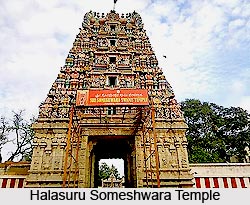 Halasuru Someshwara Temple is one of the significant temples of Karnataka state of India. It is located in the suburb of Halasuru in Bangalore, the capital of Karnataka. According to historians, it is the oldest temple in the city and dates back to the Chola period. The temple was probably built between the 12th and 13th centuries. Later, it was renovated by Kempe Gowda I and II in the 16th century. Someshwara (the Hindu god Shiva) is the main deity of this temple. Lord Vishnu and Brahma are also worshipped in this temple. The other deities worshipped here are Kamakshamma, Arunachaleswara, Bhimeswara, Nanjundeswara and Panchalingeswara.
Halasuru Someshwara Temple is one of the significant temples of Karnataka state of India. It is located in the suburb of Halasuru in Bangalore, the capital of Karnataka. According to historians, it is the oldest temple in the city and dates back to the Chola period. The temple was probably built between the 12th and 13th centuries. Later, it was renovated by Kempe Gowda I and II in the 16th century. Someshwara (the Hindu god Shiva) is the main deity of this temple. Lord Vishnu and Brahma are also worshipped in this temple. The other deities worshipped here are Kamakshamma, Arunachaleswara, Bhimeswara, Nanjundeswara and Panchalingeswara.
Architecture of Halasuru Someshwara Temple
It is a mixture of Hoysala, Chola and Vijayanagara architecture. The Rajagopuram or the temple tower and the Dhwajastambha in front of the temple are its striking features. The tower exhibits images of gods and goddesses from Hindu mythology. There are several carved pillars inside the temple premise. The temple has a square garbhagriha or sanctum which is connected to a closed hall. The entrance to the sanctum features sculptures of two "door keepers". The walls of hall are adorned with pilasters and sculptures in frieze. To the north of the temple is the shrine for the nine planets with twelve pillars, each pillar representing a saint. Recent excavation at the temple has revealed a temple tank. The tank is believed to be 1200 years old.
Festivals of Halasuru Someshwara Temple
The famous festivals of this temple are Maha Shivaratri, Brahmotsav, Kamakshamma Pallaki Utsava. Devotees on Shivaratri visit the temple for the darshan of Lord Shiva and the Pancha Lingeswaras. On the day of Kamakshamma Pallaki Utsava, the idol of Goddess Kamakshamma is taken out in procession in a palanquin around the temple. Special rituals and ceremonies are also held during Ugadi and Karthik Poornima.
Legend of Halasuru Someshwara Temple
There is a legend associated with this heritage temple. It is considered that Kempe Gowda rested under a tree as he was tired after hunting. He fell asleep. Lord Someshwara appeared in his dream and revealed the existence of hidden treasure. He told him to restructure the temple.





















